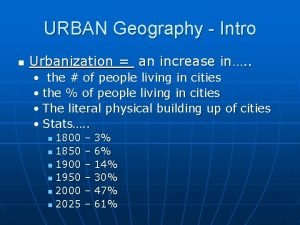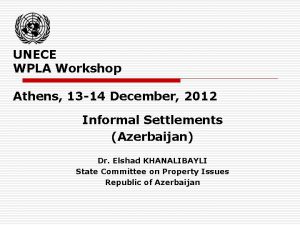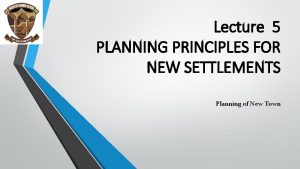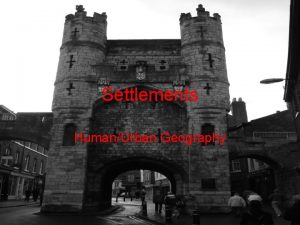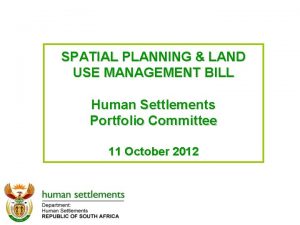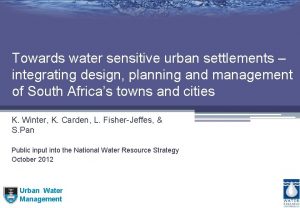Lecture 5 PLANNING PRINCIPLES FOR NEW SETTLEMENTS Planning













- Slides: 13

Lecture 5 PLANNING PRINCIPLES FOR NEW SETTLEMENTS Planning of New Town

1. INTRODUCTION • ‘settlement’ and ‘development’ used generically for residential (rural and urban), commercial, industrial and tourism development. 2 Siddiqa Amin

2. PLANNING PRINCIPLES Location Land Suitability Infrastructure Provision Siddiqa Amin Form & Hierarchy Employment Opportunities Urban Design & Heritage Tourism Opportunities 3

2. 1 LOCATION Predominantly within agreed growth areas Minimized Environmental impacts Environmental social and economic stability Sustainable Self reliant Avoid fragmented development Maximize Infrastructure Efficiency and service provision 4 Siddiqa Amin

2. 1 LOCATION • Future urban settlement should be located predominantly within the agreed growth areas. • Future settlement must be located to minimize environmental impacts and be sustainable. • Fragmented development has high infrastructure costs and is unlikely to be permitted. • To achieve future environmental, economic and social sustainability, new settlements should be able to demonstrate self-reliance and an ability to maximize infrastructure efficiency and service provision. • New, isolated settlements should not be considered if residents would be heavily dependent upon motor vehicles to access basic social and services infrastructure. Siddiqa Amin 5

2) LAND SUITABILITY (ENVIRONMENT, NATURAL RESOURCES, HAZARD) • • • Siddiqa Amin Future development should be located on land that is suitable for the development and capable of supporting the proposed uses. Planning for future development on land already zoned for settlement but not yet developed should identify the constraints and opportunities of the land. Development should achieve a carefully planned community, respecting environmental, resource and hazard issues. Future development should avoid areas of environmental significance, significant natural and/or economic resource, potential hazard, high landscape or cultural heritage value, or potential increased risk associated with impacts of climate change. Future development adjoining land with the above values should incorporate buffers as necessary to help protect those values and to avoid future land use conflict. Future development should be strategically planned by providing a timely release of 6 and adequate and appropriately located land to address the specific dwelling targets housing mix identified in the master plans.

3) SETTLEMENT FORM AND HIERARCHY • • Siddiqa Amin Future development should strengthen the hierarchy of settlement, support and maintain strong multi-functional business centres, minimize urban sprawl, and maximize infrastructure and service efficiencies; Consideration should be given to the ultimate geographical extent and population target for each community that is to be formed or built upon, and the staging/timing by which it fulfills the following needs; a) provide for a mix of houses, jobs and open space; b) be appropriately located in relation to its scale, nature or type of development; the ability to provide the necessary infrastructure and services; the need for access and to ensure effective traffic management; c) In the case of residential development, provide for a variety of dwelling types and a choice in location, form and affordability; and d) enable mixed uses and home-based employment in residential or village 7 zonings where appropriate.

3) SETTLEMENT FORM AND HIERARCHY Conti… • Future rural residential development should be a) located close to existing centres and away from areas that may in the future have values for urban expansion. b) clustered to encourage a sense of community and for the efficient provision of services. Fragmented development over the landscape may not be permitted. • Future development, particularly at the residential/agricultural and the residential/industrial interfaces, should be planned for and managed so any 8 potential conflict is minimized in relation to adjacent land uses. Siddiqa Amin

4) URBAN DESIGN AND HERITAGE Siddiqa Amin • Future development should • recognize, protect and be compatible with any unique topographic, natural or built cultural features essential to the visual setting, character, identity, or heritage significance of the area or settlement that it is to be located in. • reflect high quality design that is compatible with the local and regional attributes which make up the region’s character, such as climate, landscape, history, topography, and existing built environment. • be designed to ensure that there is public access to an adequate supply of appropriately located public open space and recreation areas, to provide for a range of recreational uses and visual amenity. • contribute to an open space facility that is designed to reflect each site’s natural features and requirements for drainage and water quality maintenance, and nature conservation and biodiversity protection. • encourage walkability and allow for easy access to public places, local shops, services and transport and lead residents to the service centre. 9 Cultural and community values should be considered in the planning for future development. •

5) INFRASTRUCTURE PROVISION • Future development should only be permitted where it can be provided with adequate, cost effective physical and social infrastructure to match the expected population for each settlement. • Future development should strengthen the efficient use of infrastructure, services and transport networks and not overburden existing services elsewhere. • Future development should be designed and located to minimize the need to travel; to maximize opportunity for efficient public transport and pedestrian access options; and to encourage energy and resource efficiency. • Future development should be designed and located to have well connected and accessible urban areas increasing the opportunity for public transport, 10 cycling and walking for residents and visitors. Siddiqa Amin

5) INFRASTRUCTURE PROVISION conti. . • Future development should not contribute to ribbon/strip development nor have impact on the safety and efficiency of major or arterial roads. • Future development should provide sufficient buffering distances and/or technological solutions between proposed development and existing or proposed major infrastructure, including rail corridors and airports. • Future development should be designed and located to maximize total water cycle management and minimize impacts on the environment. 11 Siddiqa Amin

6) EMPLOYMENT OPPORTUNITIES Siddiqa Amin • Industrial land should be made available in a variety of locations to encourage new opportunities as they arise in all major regional centers, major towns and towns. • However, location and availability should recognize the linkages of employment land with the settlement areas, markets, transport and access, environmental constraints, and cost effective provision of necessary services and infrastructure. • Commercial land, should be located so that it can be conveniently serviced, is accessible to, and is consistent in scale with the settlement it serves or is planned to serve. • If commercial land expansion is not adjacent to an existing centre then any new development should not damage the existing centre(s) and should be at a scale and 12 location only to serve the target neighbourhood.

7) TOURISM OPPORTUNITIES • • • Siddiqa Amin Future tourism development should not negatively impact on the natural, economic or social fabric of the area it is to be located in. Future tourism development should provide for a wide range of experience opportunities from the low cost family type tourism developments, such as grounds, to large development. Small scale or low cost tourism development includes holiday cabins, camping grounds, guest houses and hostels, and the like. Large scale development means large holiday unit complexes, large hotels, or integrated resorts which may incorporate recreation facilities, commercial facilities, golf courses and permanent residential accommodation. Future investment in and growth of tourism products and services should not occur at the expense of local environmental and social values. Future large scale tourism development that is located adjoining natural features such a beach, national park or reserve, etc, should maintain public access to 13 those features.
 01:640:244 lecture notes - lecture 15: plat, idah, farad
01:640:244 lecture notes - lecture 15: plat, idah, farad Multiple nuclei model definition geography
Multiple nuclei model definition geography 300000/260
300000/260 Compagnie des indes orientales pronunciation
Compagnie des indes orientales pronunciation River rock funds
River rock funds Geography grade 12 settlement questions and answers
Geography grade 12 settlement questions and answers Citystate informal settlements
Citystate informal settlements Major indigenous settlements in tennessee
Major indigenous settlements in tennessee Functions of settlements
Functions of settlements East india company flag
East india company flag Viking territory map
Viking territory map Clustered vs dispersed settlements
Clustered vs dispersed settlements European colonies in north america
European colonies in north america Good settlement
Good settlement

